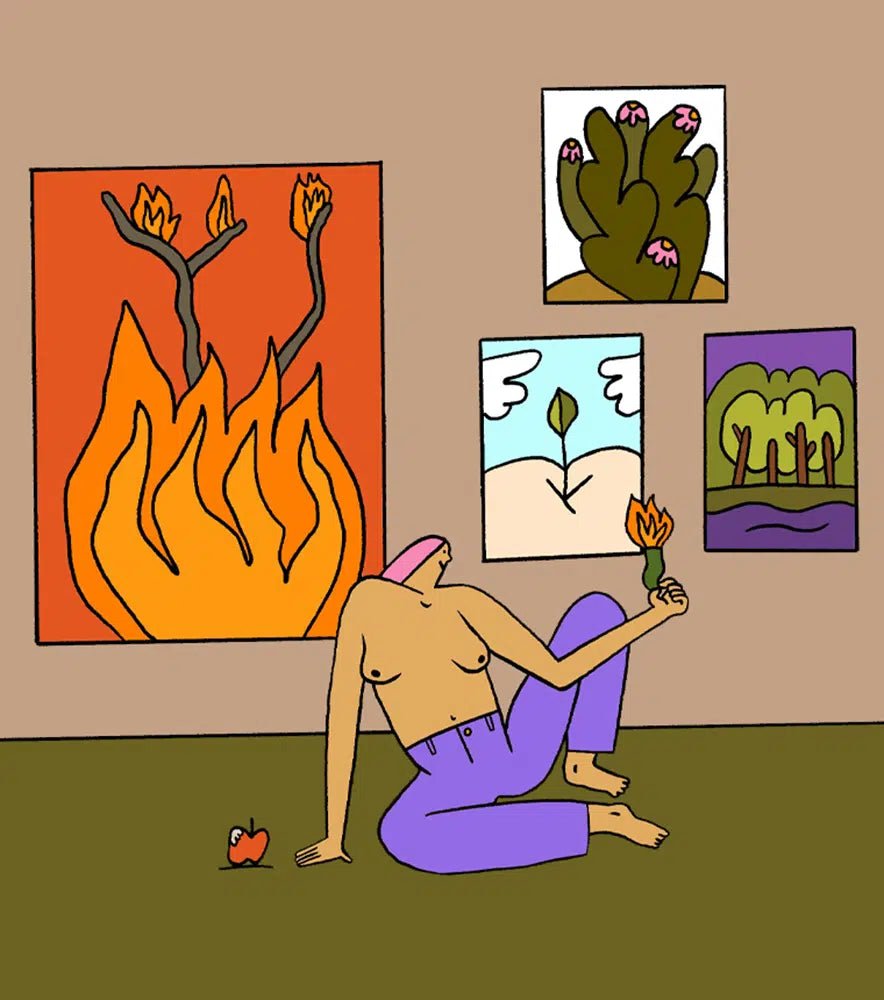“Feminism or Death” is the title of the book by Francoise d’Eaubonne – the woman who was one of the first to recognise the connections between the climate and gender crises. Her work coined the term ecofeminism. According to her, both crises can be traced back to an arbitrarily created hierarchy: capitalist patriarchy.
Emilie Hache, professor of ecological philosophy, aptly describes the connection between the two crises: Women1 are considered inferior because they are part of nature, and nature in turn can be abused because it has female connotations.2 Thus, women are demonstrably much more affected by climate disasters than men: according to the UN, the risk of dying in a climate disaster is fourteen times higher for women than for men 3 – which proves the title “Feminism or Death” mentioned at the beginning to be frighteningly apt.
The higher vulnerability of women to the consequences of the climate crisis can be explained by the fact that “female-socialised people […] tend to have fewer opportunities [to protect themselves], as they often have more difficult access to information, fewer financial resources and less say.”4 Due to the absence of women in political decision-making bodies, the solutions proposed to combat the climate crisis are also shaped by patriarchal patterns of thinking. e.g. certain sectors are more protected from environmental disasters and their consequences than others.5
Women and nature
“If half the population is structurally disadvantaged, that also makes society as a whole more vulnerable to climate shocks.”
Marina Andrijevic, IIASA
If women were more involved in these decisions, things would look very different, according to Marina Andrijevic, an economist at the International Institute for Applied Systems Analysis: “If half the population is structurally disadvantaged, that also makes society as a whole more vulnerable to climate shocks.”6 According to a study in the journal Nature Communications, in order to manage and prevent climate disasters, it is necessary to give women more of a voice, as they know the dangers from their own lives and what needs to be changed to make their environment safer.7 Another study, published in the European Journal of Political Economy, also establishes a link between the number of female MPs and the country’s CO2 emissions: the more women in parliament, the lower the latter.8
“No matter where ecological destruction took place, it was always women who rose up.”
Vandana Shiva, climate activist
Historically, women were always assigned to nature, while men stood for the cultural. But it has nothing to do with this long-outdated dualism that women generally care more about nature and the environment. Vandana Shiva, a climate activist known as an eco-feminist since the 1970s, explains this tendency as follows: “No matter where ecological destruction took place, it was always women who rose up, not because their genes told them they were closer to nature, but because it was left to them to take care of the basic things of life, food and water and fuel and all the things that are not considered work, that are not considered part of the economy. So they were left to look after these basic things that sustain society, and so they became experts in sustainability, in ecology, in survival.”9
Even today, it is mainly women who are fighting for these issues. The pioneers of the climate change movement Fridays for Future are predominantly female – women made up 70 per cent of the 1.6 million strikers at the first international climate strike in 2019.10
The link between ecofeminism and fashion
Many observations of ecofeminism can be transferred to the fashion industry without difficulty: here, too, it is mainly women who produce our clothes under precarious working conditions, can hardly secure themselves due to the low wages, additionally perform care work in their families, are regularly sexually harassed and at the same time are strongly underrepresented in leadership and decision-making positions. Due to their economically weakened position, they are also much more exposed to the consequences of the climate catastrophe and have fewer possibilities to protect themselves from them.
Sustainable fashion brands are taking various approaches to break this cycle. They not only use more environmentally friendly materials, rely on recycling and smaller-scale production. They also pay fair wages to their garment workers to empower them to become more self-reliant and secure their own financial security. Many of them also offer their employees opportunities to further their education and to form workers’ associations. In this way, these brands are taking the first steps towards what ecofeminism is also striving for: To finally stop exploiting the resources of nature and people, but instead to strengthen their rights.11
1.In this article, the terms “women” and “men” only refer to cis-women and cis-men. Of course, other socially disadvantaged groups are also affected by the effects of capitalist patriarchy. Unfortunately, however, since there are hardly any studies that include these groups, this text cannot adequately report on them.
2 https://reporterre.net/Emilie-Hache-Pour-les-ecofeministes-destruction-de-la-nature-et-oppression-des-femmes
3 https://www.bbc.com/news/science-environment-43294221
4 https://www.wecf.org/de/ohne-gehts-nicht-klimagerechtigkeit-braucht-feminismus/
5 https://enorm-magazin.de/gesellschaft/gleichstellung/feminismus/feminismus-und-klimawandel-keine-klimakrise-ohne-geschlecht
6 https://www.zeit.de/2022/04/klimawandel-auswirkungen-frauen-kinder-forschung
7 ibid.
8 ibid.
9 https://www.pressenza.com/de/2021/04/frauen-die-die-zukunft-gestalten-vandana-shiva/
10 https://www.zeit.de/politik/ausland/2020-06/oekofeminismus-frankreich-hierarchie-aufhebung-frau-mann-klimaschutz/
11 https://www.gwi-boell.de/de/2020/11/06/ohne-gehts-nicht-klimagerechtigkeit-braucht-feminismus
Illustration: © Tanya Teibtner
